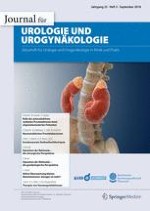Anzeige
11.09.2018 | Originalien
Neuroendokrines Prostatakarzinom
Erschienen in: Journal für Urologie und Urogynäkologie/Österreich | Ausgabe 3/2018
Einloggen, um Zugang zu erhaltenZusammenfassung
Neuroendokrine Prostatakarzinome (NEPC) treten zumeist in Form eines gemischt neuroendokrin-azinären Prostatakarzinoms auf, das sich unter antiandrogener Therapie entwickelt (t-NEPC). Etwa 30–40 % aller metastasierten kastrationsresistenten Prostatakarzinome weisen neuroendokrine Anteile auf. Primäre kleinzellige Prostatakarzinome sind hingegen äußerst selten. Ein t‑NEPC sollte in Betracht gezogen werden, wenn trotz rascher Progression ein disproportional niedriger PSA(prostataspezifisches Antigen)-Wert vorliegt und neuroendokrine Marker wie Chromogranin A oder neuronenspezifische Enolase erhöht sind. Hierbei korreliert das Risiko für die Entwicklung eines t‑NEPC mit dem initialen Gleason-Score. Die Therapie orientiert sich an der Behandlung kleinzelliger Bronchialkarzinome. Bei negativem PSA ist eine Chemotherapie mit Cisplatin und Etoposid Therapie der Wahl, worunter Ansprechraten von 30–60 % mit einem medianen Überleben von meist unter einem Jahr erreicht werden können. Bei deutlich erhöhtem PSA sollte eine Chemotherapie mit Carboplatin und Docetaxel erwogen werden.
